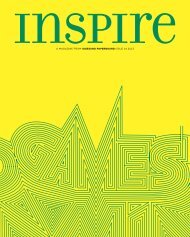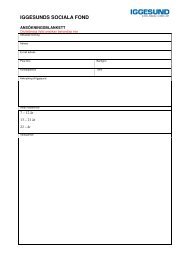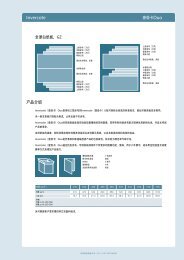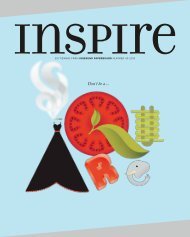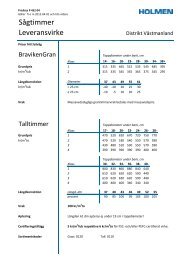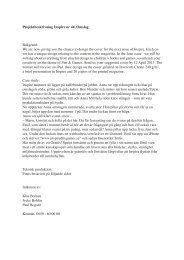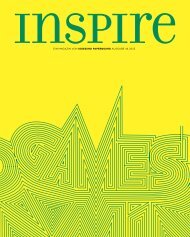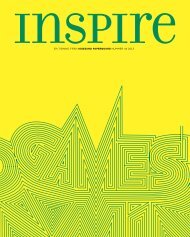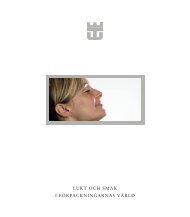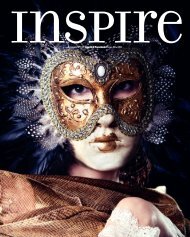Scandinavian Design Classics brochure - Iggesund
Scandinavian Design Classics brochure - Iggesund
Scandinavian Design Classics brochure - Iggesund
Create successful ePaper yourself
Turn your PDF publications into a flip-book with our unique Google optimized e-Paper software.
<strong>Scandinavian</strong> <strong>Design</strong> <strong>Classics</strong> from1963THE BIRTH OFGRAPHIC DESIGN: Position ABPHOTOS: Rolf Andersson, Bild-bolaget, Jeffrey Nishinaka on page 21.PRINTING: Ineko AB, SwedenCOVER: Invercote Creato 240 g/m 2 , insert: Invercote Creato 200 g/m 2© <strong>Iggesund</strong> Paperboard 2013
SCANDINAVIAN DESIGN CLASSICS FROM1963THE BIRTH OFThe creative output of Swedish designerStig Lindberg ranged from ceramicfeature walls in the Al Rashid Hotel inBaghdad to the design of televisionsand illustrations for children’s books.Lindberg was best known as the artisticdirector of the Swedish porcelain factoryGustavsberg. There he was responsiblefor many successful dinnerwareservices, which were extremely popularin Swedish homes.His Berså series was made in largequantities in the early 1960s and hasbecome a highly valued design classic.
SCANDINAVIAN DESIGN CLASSICS FROM1963THE BIRTH OFStorebro is a small inland locality in southern Sweden wheremany refugees from Estonia and Latvia settled before andduring World War II. Most of them got jobs at the biggestlocal company, Storebro, which did metal working. Whenowner Ivar Gustafsson discovered that many of his newemployees had brought boatbuilding skills with them fromtheir home countries, he began producing wooden boats ona large scale. One of the first successful models was calledSolö. The production expanded and in time came to includeconsiderably larger and more luxurious boats.
SCANDINAVIAN DESIGN CLASSICS FROM1963THE BIRTH OFBRIO is known worldwide for its wooden toys. Founded in 1884 in the southern Swedishprovince of Skåne, the company originally made baskets but soon began focusing more andmore on toys. BRIO toys are designed to be learning tools and are easily recognised by theirdistinctive shapes and colour scheme. BRIO is best known for its toy trains and tracks, allmade of wood.Today the toys are made in China but are still developed and designed in Sweden. BRIOstill has a toy museum in Osby, Skåne.
SCANDINAVIAN DESIGN CLASSICS FROM1963THE BIRTH OFCH07 is the uninspiring name of this chair by Danish furniture designer Hans Wegner. In the course of his career he created more than500 chairs, all based on the conviction that a chair should not only be functional but also aesthetic. The CH07 premiered in a small editionin 1963 and was then forgotten, only to be rediscovered in the 1990s and put back into production to great international success.
SCANDINAVIAN DESIGN CLASSICS FROM1963THE BIRTH OFThe Plug Inn wall clock was not designed by a <strong>Scandinavian</strong> but by a Dutchman, Frits Vink,who created many exciting clocks. However, its clean lines and restrained elegance made the clock a favourite with the <strong>Scandinavian</strong> publicand it was a bestseller in the early 1960s. Vink worked for NASA on designs for the space industry before launchinghis own business focusing on consumer products.
SCANDINAVIAN DESIGN CLASSICS FROM1963THE BIRTH OFEven before World War II designer Ralph Lysellwas working to create a one-piece phone forthe Swedish telephone company Ericsson. Thatdevelopment work was suspended during the warbut was resumed by Lysell’s designer colleagueGösta Thames. The final result was the Ericofon,later better known as the Cobra. The inventors, bothwith an engineering background, could hardly haveimagined that a few decades later their creationwould feature in design museums around the worldand constantly appreciate in price.
SCANDINAVIAN DESIGN CLASSICS FROM1963THE BIRTH OFThis compact record player with a built-in speaker in the lid was a status symbol among Swedish teenagers in the 1960s,long before ghetto blasters and Walkmans. The functional design was created by engineers at Luxor’s design department. The Luxor brand,which dominated <strong>Scandinavian</strong> consumer electronics in the 1960s, was inspired by something so far away as the tomb of the Egyptian pharaoh Tutankhamen.The tomb was a recent discovery when the company’s founder was searching for a brand name with international flairso the company was named after the city closest to the tomb.
SCANDINAVIAN DESIGN CLASSICS FROM1963THE BIRTH OFHekla is one of Iceland’s most active volcanoes, located 110 kilometreseast of Reykjavik and rising to a height of 1,491 metres. But it is alsothe name of a lamp created by Petur B Luthersson and Jon Olafssonin the first revolutionary design years of the 1960s. The prototypewas made of paperboard but the lamp was later produced in othermaterials. Only 15,000 Hekla lamps were made and they are now ingreat demand as vintage collectables. A relaunch of the lamp is beingconsidered.
SCANDINAVIAN DESIGN CLASSICS FROM1963THE BIRTH OFThe Spotnicks were Sweden’s first big popular music export. This instrumental rock group got a real boost when its membersadopted the space age optimism of the 1960s and began performing in ‘space suits’. The suits were a hit with the public but madetheir wearers perspire heavily on stage. The band was high on the charts for a number of years in the UK, Germany and Japanas well as Sweden. The group’s second album, The Spotnicks in Paris, was released in 1963.
SCANDINAVIAN DESIGN CLASSICS FROM1963THE BIRTH OFNorway’s Tias Eckhoff is representedin a number of museums in Europeand the United States. He beganhis career as a ceramic artist anddesigned a number of dinnerwareservices but is best known for hiscutlery. As early as 1952 he createdthe Cypress flatware service for theDanish design firm Georg Jensen.At the beginning of the 1960s hedesigned Maya for the Danish firmStelton. With its rounded edges,this elegant cutlery fits snugly inthe hand and has won numerousawards, including the Norwegian<strong>Design</strong> Award and the Classic Awardfor <strong>Design</strong> Excellence from thenorwegian <strong>Design</strong> Council.
SCANDINAVIAN DESIGN CLASSICS FROM1963THE BIRTH OFClothes and shoes for liberated women – that wasthe guiding principle of Katja Geiger, founder of thebrand Katja of Sweden. She advocated a simplicitythat was closer to the American tradition of everydaywear than to the French haute couture focus onfestive occasions. Her signature style was formfitting,comfortable clothing in bright colours, ofteninspired by woven textiles from Sweden’s traditionalpeasant culture. In the mid-1960s she also beganshowing her designs in Paris to great success.
SCANDINAVIAN DESIGN CLASSICS FROM1963THE BIRTH OFFrom its home base in a remote forested region of Sweden, the accordion firm of Hagströmdominated the Nordic market for the instruments in the 1940s and ’50s. In 1952 the founder,Albin Hagström, died. To learn the music industry, his son and heir Karl-Erik was sent to theUnited States in the mid-1950s. To pay for the trip, he had with him a small stock ofaccordions to sell. After a few months he returned with the bitter news that it wasimpossible to sell accordions because everyone over there wanted electric guitars.The company immediately began making guitars. In time it was so successful thatthe artists who used its guitars included Elvis Presley, Frank Zappa, Jimi Hendrix,The Eagles, David Bowie and ABBA.
SCANDINAVIAN DESIGN CLASSICS FROM1963THE BIRTH OFINVERCOTE YOUR DESIGNSince 1963 – for fifty years – <strong>Iggesund</strong> Paperboard has been makingInvercote ® . In that time Invercote has come to be a favourite amongdesigners who work with demanding applications ingraphic production or packaging.Superb printing properties combined with flexibility, shapeabilityand surface smoothness make Invercote highly popular amongdesigners who seek elegance, perfection and functionality.Invercote is a design product with its roots in one of the golden agesof design – the early 1960s. While its white, flat appearance mightnot make it as eye catching as some of its design contemporaries,when Invercote is combined with the fantastic creativity shown by ourcustomers the final results can more than hold their ownamong the world’s design greats.We thank all of you who are using Invercoteto show what true designer freedom is.
<strong>Iggesund</strong> Paperboard has been making Invercotesince 1963 but was founded much earlier, in1685. Over the centuries the company survived onwhat the forest provided. Access to timber gavecharcoal to produce iron, then sawn timber, woodpulp and, since 1963, paperboard.Most of the timber comes from <strong>Iggesund</strong>and its sister companies’ own forests, whosemanagement is certified in accordance withboth the Forest Stewardship Council (FSC ® ) andthe Programme for the Endorsement of Forestcertification (PEFC TM ).Invercote is produced in <strong>Iggesund</strong>, Swedenat one of the world’s most advanced pulp andpaperboard mills. Biofuel provides 95 per cent ofthe energy needed to power the manufacturingprocess, so fossil carbon dioxide emissions areextremely low.63-13<strong>Iggesund</strong>’s aim is that Invercote will alwaysproduce a dazzling end result, while at the sametime designers, printers and converters will feel itgives them first-class performance and creativefreedom.iggesund.comCO13014E



